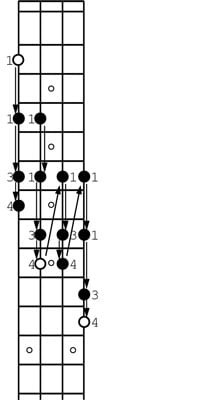Because of the size of the bass guitar, you'll need to shift your left hand out of position in order to play two-octave major scales. To shift your hand smoothly, you need to anticipate where your hand will be for the next several notes (not just for the next note) so that your musical phrase or scale can flow smoothly even though your hand is making a shift.
Review the structure of the two-octave major scale.

The E-major scale begins on the open (unfretted) E string, and its major scale pattern is unique. For every other scale, the first note is fretted. Be sure to refer back to this structure while you’re playing. (If you happen to be a lefty, please read “right hand” to mean “left hand,” and vice versa.)
Press the index finger of your left hand down on any note on the E string, the thickest string, and strike the note with your right hand.
This note is your root (the first note in the scale). If you're playing the E major scale, you don't fret anything — just strike the open string.
Shift your left hand by two frets toward the bridge along the E string to play the next three notes.
On the E string, fret with your index finger, then your ring finger, and then your pinkie, striking each note with the right hand as you fret it. If you're playing the E major scale, this isn't shift — you just start fretting at the second fret.
Stay in position and move the index finger of your left hand from the E string to the A string.
Fret with your index finger and strike the A string.
Shift your left hand toward the bridge by two frets along the A string and play the next three notes.
On the A string, fret with your index finger, then your ring finger, and then your pinkie, striking each note with the right hand as you fret it. Now you're exactly one octave above the original starting note.
Stay in position and move the A string across to the D string and play the next three notes.
Just like before, but on the D string, fret with your index finger, then your ring finger, and then your pinkie, striking each note with the right hand as you fret it.
Stay in position and press the index finger of your left hand on the G string.
Fret with your index finger and strike the G string.
Shift your left hand by two frets toward the bridge along the G string and finish the scale.
You're nearly to the top! On the G string, fret with your index finger, then your ring finger, and then your pinkie, striking each note with the right hand as you fret it. Voilà! You’re now exactly two octaves above the original root note.
You'll notice that your poor left-hand middle finger has nothing much to do but hang out (figuratively) while you play this scale. Practice playing up and down the scale, building speed and fluidity as you go. Eventually, you'll be able to play it in your sleep.

